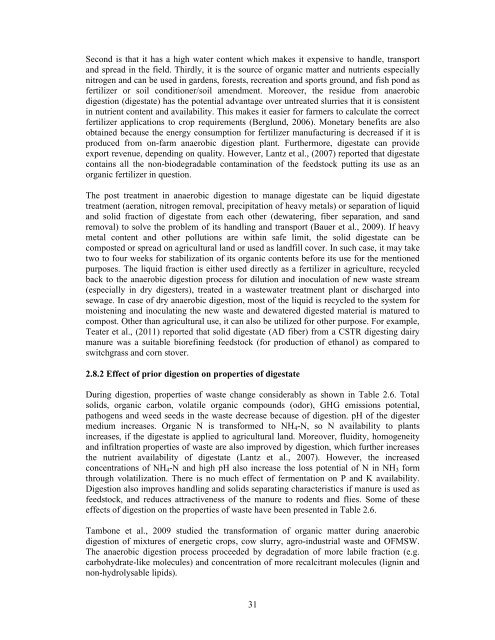dry anaerobic digestion of municipal solid waste and digestate ...
dry anaerobic digestion of municipal solid waste and digestate ...
dry anaerobic digestion of municipal solid waste and digestate ...
You also want an ePaper? Increase the reach of your titles
YUMPU automatically turns print PDFs into web optimized ePapers that Google loves.
Second is that it has a high water content which makes it expensive to h<strong>and</strong>le, transport<br />
<strong>and</strong> spread in the field. Thirdly, it is the source <strong>of</strong> organic matter <strong>and</strong> nutrients especially<br />
nitrogen <strong>and</strong> can be used in gardens, forests, recreation <strong>and</strong> sports ground, <strong>and</strong> fish pond as<br />
fertilizer or soil conditioner/soil amendment. Moreover, the residue from <strong>anaerobic</strong><br />
<strong>digestion</strong> (<strong>digestate</strong>) has the potential advantage over untreated slurries that it is consistent<br />
in nutrient content <strong>and</strong> availability. This makes it easier for farmers to calculate the correct<br />
fertilizer applications to crop requirements (Berglund, 2006). Monetary benefits are also<br />
obtained because the energy consumption for fertilizer manufacturing is decreased if it is<br />
produced from on-farm <strong>anaerobic</strong> <strong>digestion</strong> plant. Furthermore, <strong>digestate</strong> can provide<br />
export revenue, depending on quality. However, Lantz et al., (2007) reported that <strong>digestate</strong><br />
contains all the non-biodegradable contamination <strong>of</strong> the feedstock putting its use as an<br />
organic fertilizer in question.<br />
The post treatment in <strong>anaerobic</strong> <strong>digestion</strong> to manage <strong>digestate</strong> can be liquid <strong>digestate</strong><br />
treatment (aeration, nitrogen removal, precipitation <strong>of</strong> heavy metals) or separation <strong>of</strong> liquid<br />
<strong>and</strong> <strong>solid</strong> fraction <strong>of</strong> <strong>digestate</strong> from each other (dewatering, fiber separation, <strong>and</strong> s<strong>and</strong><br />
removal) to solve the problem <strong>of</strong> its h<strong>and</strong>ling <strong>and</strong> transport (Bauer et al., 2009). If heavy<br />
metal content <strong>and</strong> other pollutions are within safe limit, the <strong>solid</strong> <strong>digestate</strong> can be<br />
composted or spread on agricultural l<strong>and</strong> or used as l<strong>and</strong>fill cover. In such case, it may take<br />
two to four weeks for stabilization <strong>of</strong> its organic contents before its use for the mentioned<br />
purposes. The liquid fraction is either used directly as a fertilizer in agriculture, recycled<br />
back to the <strong>anaerobic</strong> <strong>digestion</strong> process for dilution <strong>and</strong> inoculation <strong>of</strong> new <strong>waste</strong> stream<br />
(especially in <strong>dry</strong> digesters), treated in a <strong>waste</strong>water treatment plant or discharged into<br />
sewage. In case <strong>of</strong> <strong>dry</strong> <strong>anaerobic</strong> <strong>digestion</strong>, most <strong>of</strong> the liquid is recycled to the system for<br />
moistening <strong>and</strong> inoculating the new <strong>waste</strong> <strong>and</strong> dewatered digested material is matured to<br />
compost. Other than agricultural use, it can also be utilized for other purpose. For example,<br />
Teater et al., (2011) reported that <strong>solid</strong> <strong>digestate</strong> (AD fiber) from a CSTR digesting dairy<br />
manure was a suitable biorefining feedstock (for production <strong>of</strong> ethanol ) as compared to<br />
switchgrass <strong>and</strong> corn stover.<br />
2.8.2 Effect <strong>of</strong> prior <strong>digestion</strong> on properties <strong>of</strong> <strong>digestate</strong><br />
During <strong>digestion</strong>, properties <strong>of</strong> <strong>waste</strong> change considerably as shown in Table 2.6. Total<br />
<strong>solid</strong>s, organic carbon, volatile organic compounds (odor), GH G emissions potential,<br />
pathogens <strong>and</strong> weed seeds in the <strong>waste</strong> decrease because <strong>of</strong> <strong>digestion</strong>. pH <strong>of</strong> the digester<br />
medium increases. Organic N is transformed to NH4-N, so N availability to plants<br />
increases, if the <strong>digestate</strong> is applied to agricultural l<strong>and</strong>. Moreover, fluidity, homogeneity<br />
<strong>and</strong> infiltration properties <strong>of</strong> <strong>waste</strong> are also improved by <strong>digestion</strong>, which further increases<br />
the nutrient availability <strong>of</strong> <strong>digestate</strong> (Lantz et al., 2007). However, the increased<br />
concentrations <strong>of</strong> NH4-N <strong>and</strong> high pH also increase the loss potential <strong>of</strong> N in NH3 form<br />
through volatilization. There is no much effect <strong>of</strong> fermentation on P <strong>and</strong> K availability.<br />
Digestion also improves h<strong>and</strong>ling <strong>and</strong> <strong>solid</strong>s separating characteristics if manure is used as<br />
feedstock, <strong>and</strong> reduces attractiveness <strong>of</strong> the manure to rodents <strong>and</strong> flies. Some <strong>of</strong> these<br />
effects <strong>of</strong> <strong>digestion</strong> on the properties <strong>of</strong> <strong>waste</strong> have been presented in Table 2.6.<br />
Tambone et al., 2009 studied the transformation <strong>of</strong> organic matter during <strong>anaerobic</strong><br />
<strong>digestion</strong> <strong>of</strong> mixtures <strong>of</strong> energetic crops, cow slurry, agro-industrial <strong>waste</strong> <strong>and</strong> OFMSW.<br />
The <strong>anaerobic</strong> <strong>digestion</strong> process proceeded by degradation <strong>of</strong> more labile fraction (e.g.<br />
carbohydrate-like molecules) <strong>and</strong> concentration <strong>of</strong> more recalcitrant molecules (lignin <strong>and</strong><br />
non-hydrolysable lipids).<br />
31

















